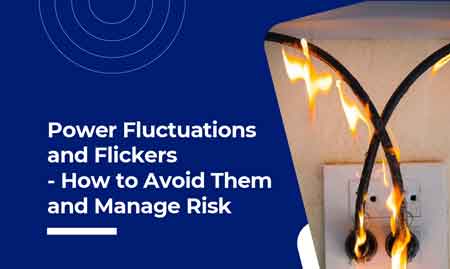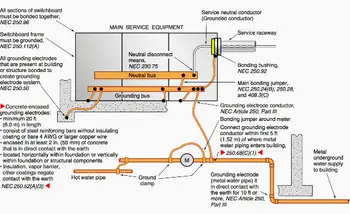Power Flickering: Causes and Prevention

Grounding and Bonding and The NEC - Section 250
Our customized live online or in‑person group training can be delivered to your staff at your location.

- Live Online
- 12 hours Instructor-led
- Group Training Available
Download Our OSHA FS3529 Fact Sheet – Lockout/Tagout Safety Procedures

- Learn how to disable machines and isolate energy sources safely
- Follow OSHA guidelines for developing energy control programs
- Protect workers with proper lockout devices and annual inspections
Power flickering refers to brief, repetitive changes in light intensity caused by voltage fluctuations. It can result from electrical faults, large motor startups, or grid instability, and may signal underlying issues that affect equipment performance and energy reliability.
Power Quality Analysis Training
Request a Free Power Quality Training Quotation
What is "power flickering"?
Power flickering is the visible fluctuation in lighting due to rapid voltage changes in an electrical system.
✅ Indicates potential issues with grid or equipment stability
✅ Common in homes with aging infrastructure or large appliances
✅ Can damage sensitive electronics over time
Frequently Asked Questions
What causes power flickering in a home or business?
It is typically caused by brief interruptions in the flow of electricity through the electrical system. These interruptions can occur due to a variety of factors. One common cause is tree branches making contact with overhead electrical lines during high winds, creating momentary disruptions. Additionally, loose connections within the electric service panel or faulty grounding systems can lead to flickering lights. External factors, such as momentary outages or voltage drops from the utility provider, can also result in flickering.
Can it damage electrical devices or appliances?
Yes, frequent flickering can damage electrical devices, particularly those sensitive to voltage fluctuations. Repeated surges caused by flickers can shorten the lifespan of appliances and electronics by overloading their circuits. In severe cases, frequent flickering can cause irreversible damage to high-end devices, resulting in costly repairs or replacements. Installing surge suppression systems and considering a UPS for critical equipment can help protect devices from damage.
Why do lights flicker during storms or high winds?
Storms or high winds are common causes of power flickering. Tree branches blowing into overhead distribution lines can create momentary disruptions in the electricity flow, causing lights to flicker. Additionally, heavy winds or lightning strikes can damage sensitive equipment like capacitors, resulting in temporary outages or reduced voltage levels. While momentary outages are often resolved quickly by utility companies, repeated flickering can be an early warning of damage that may eventually lead to a full electricity outage.
Sign Up for Electricity Forum’s Power Quality Newsletter
Stay informed with our FREE Power Quality Newsletter — get the latest news, breakthrough technologies, and expert insights, delivered straight to your inbox.
What should I do if I experience frequent power flickering?
If you experience frequent flickering, the first step is to inspect your electric service panel for loose connections. If you're unsure or uncomfortable doing this yourself, hiring a licensed electrician is a safer and more reliable option. Additionally, check for external issues, such as tree branches that may be in contact with electricity lines. If these external factors seem to be the cause, contact your utility provider. Understanding electrical grounding can help you better diagnose potential in-home wiring problems.
Frequent flickering may also signal aging wiring or faulty neutral conductors, which should be inspected and repaired to prevent further problems.
How can it be prevented?
Preventing power flickering involves addressing both internal and external causes. Internally, ensuring your electrical system is up to code and that all wiring connections are secure can help avoid flickers. For added protection, installing automatic power factor controllers or investing in a UPS system for sensitive devices will help mitigate the effects of voltage fluctuations. Externally, keeping tree branches trimmed away from distribution lines reduces the chance of branches making contact during storms, which can cause service interruptions. If flickering persists, contact your utility company to ensure there are no larger issues with your local electricity supply.
It can be a sign of various issues ranging from external factors like weather to internal problems in your home’s electrical system. Identifying the root cause and addressing it early can help prevent potential damage to your electrical equipment and ensure the reliability of your electric service. By taking proper precautions, such as using surge protectors and monitoring your power factor, you can reduce the likelihood of flickering and the associated risks.








